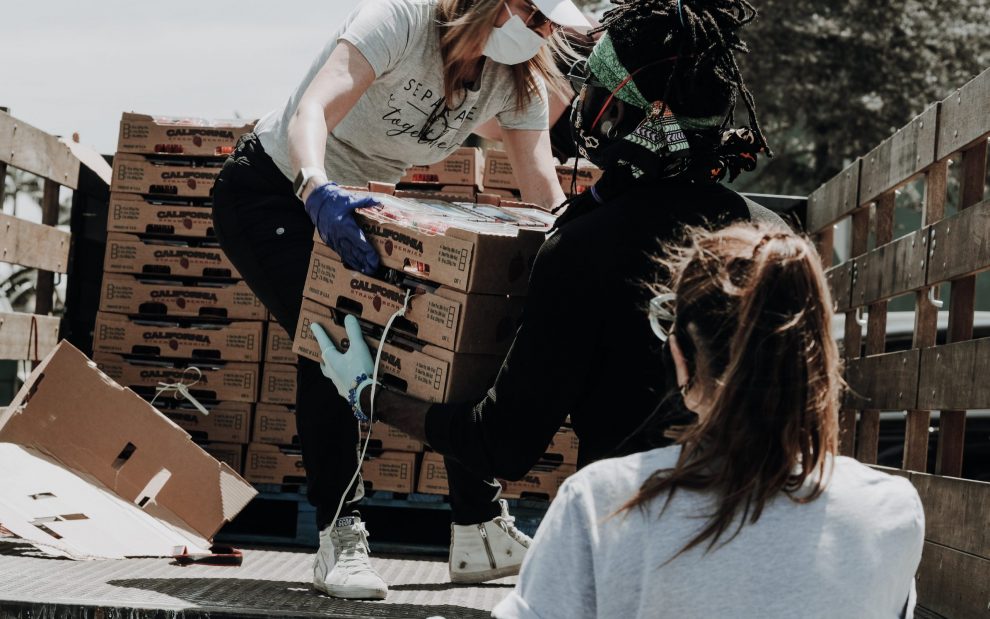As the holiday season approaches, many parishes are undoubtedly preparing to launch annual gift drives to mark the season. Some will hang ornaments on a tree suggesting gifts of toys and clothing for children in need. Others will seek bags of donated food, shipping them off to a regional food pantry in time for holiday meals. These activities seem to fulfill the essential command of Christ to practice almsgiving, especially in commemoration of his birth. Are these practices really the best way to celebrate the season? Or could we do better?
The question here is not one of bad intentions. Yet there is something problematic about these sorts of drives. In a sense, one could say they fall into a no-man’s-land between charity and justice—between the Christian call to do the concrete works of mercy and the importance of action to address what Catholic social teaching calls “structures of sin” that reflect and reinforce ongoing injustice.
The great value of the charitable works of mercy—feeding the hungry, clothing the naked, comforting the sick—is their hands-on, person-to-person quality. When Jesus teaches about them in Matthew 25, people ask, “When did we see you in need?” Like the Good Samaritan who does not pass by the one in need on the side of the road, the works of mercy involve directly encountering suffering and acting to alleviate it. The discomfort we feel when encountering the homeless or the sense of awe we have at Dorothy Day’s life both stem from the centrality of this actual compassionate encounter with suffering.
The great problem with most parish-based charitable drives is that there is no such encounter. There is no vulnerability. Pope Francis’ whole ministry is rooted in the importance of this encounter and accompaniment. In Evangelii Gaudium (The Joy of the Gospel), his first major work after taking office, he writes movingly that “Jesus wants us to touch human misery. . . . He hopes that we will stop looking for those personal or communal niches which shelter us from the maelstrom of human misfortune and instead enter into the reality of other people’s lives and know the power of tenderness.” He admits that when this real encounter happens, our lives will become “wonderfully complicated.”
The parish-based drive is certainly simplistic and efficient, especially since the rich and the poor are geographically separated from one another in too many of our cities and towns. But the structure of the drive also has an invulnerability built into it. We feel we have done our part to help out the “less fortunate” without ever actually needing to encounter them.
On the other hand, charitable gestures risk taking both attention and resources away from deeper questions of justice. The real needs of children living in poverty are not toys, and perhaps we all have enough experience with gifts of clothing chosen by others who don’t know us to wonder how “exciting” such gifts will be.
Are these practices really the best way to celebrate the season?
Again, the intention is good. An important reason why people give to toy drives is a recognition that poorer parents may be embarrassed by their inability to get gifts for their kids as socially expected. These items help parents manage that, especially in cases where they might skimp on essentials in order to afford gifts. Nevertheless, can we recognize that, in underwriting the obligatory participation in the Christmas shopping frenzy, we support precisely the “consumerism” that St. Pope John Paul II and subsequent popes have all explicitly condemned?
Consider how we might find an alternative to these approaches. Perhaps we might recognize the great value of a Catholic education and pool gifts to offer better scholarships and discounts for poorer families to send their children to Catholic schools. This is a true gift—and, moreover, one that not only benefits the children in the long run but also strengthens a key institution of the church itself rather than just enriching the coffers of toy manufacturers and retailers.
Or in light of the ongoing pervasiveness of racial injustice, we might imagine contributing to organizations that work actively on the hard task of racial reconciliation, thus better imaging the gifts of the “three kings” who represent all the nations of the earth coming together in unity. These sorts of practices would better direct our Christmas energies toward genuine justice.
The great problem with most parish-based toy drives is there is no such encounter.
These approaches, however, should not preclude considering alternatives for charitable giving. They should encourage ones that enable the face-to-face accompaniment of which Francis speaks. For example, rather than a food drive, why not consider having members of one parish plan and prepare a holiday feast for another parish more in need? Members of both parishes could collaborate. It would be great if members of both parishes worked together preparing food and finding door prizes, even if the funds came disproportionately from the “more fortunate.” Although this will hardly solve poverty, it could do a much better job of bringing people into contact with one another.
It would be great if such an event could also include shared storytelling, some witness about struggles faced during the year (again, from both groups), and communal prayer. The event could take many formats, but whatever the format, it would involve a kind of encounter that is missing from the annual parish-based drives. One of the many laments of the year of COVID-19 is that this kind of gathering will have to be a plan for future years, not this one! But now is the time to start thinking forward about it.
If we want a template for what holiday giving that combines justice and true charity might look like, we could challenge our imaginations with Frank Capra’s well-known Christmas parable, It’s a Wonderful Life. Faced with both business failure and bitter regrets about the limitations of his own life, George Bailey contemplates suicide. Of course an angel shows him all the ways his life has made a difference in the world. But from the angle of social justice and the works of mercy, we should notice two things about how the story ends, things that are not about a mystic angelic reverie.
Can we recognize that, in underwriting the obligatory participation in the Christmas shopping frenzy, we support precisely the consumerism that St. Pope John Paul II and all subsequent popes have explicitly condemned?
When George returns from his joyous sprint through the snowy streets of Bedford Falls, he arrives home to find the whole community coming and pitching in their dollars to help his business out of a difficult situation. And the business itself, the old Bailey Building and Loan, is the instrument that has made possible homeownership for many of the poor in the community, pooling their resources and treating them humanely in managing their mortgage, by contrast with the tight-fisted and ruthless banker and landlord Mr. Potter. The Bailey Building and Loan represents an institution of justice. The line of Christmas givers at the Bailey home, pitching in their dollars, represents the true essence of charity: encountering and helping particular people directly in their time of dire need, just as the angel shows what George has done throughout his own life.
How might we shift our plans so that something like that characterizes our parish program in order to better celebrate God’s greatest of all gifts to us?
This article also appears in the December issue of U.S. Catholic (Vol. 85, No. 12, pages 34-35). Click here to subscribe to the magazine.
Image: Unsplash/Joel Muniz













Add comment